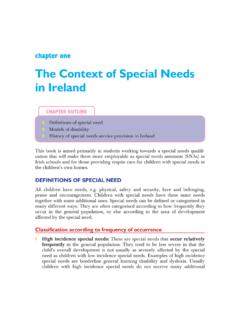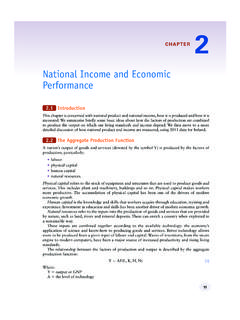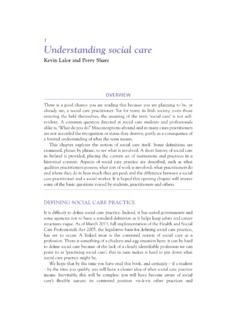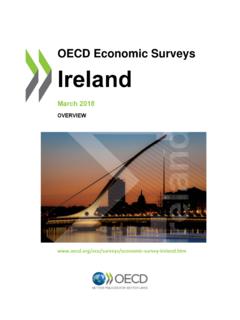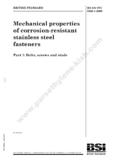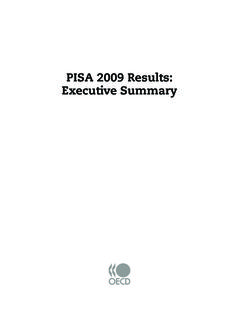Transcription of 1 Historical Development of the ECEC sector in …
1 HistoricalDevelopment ofthe ECEC sector in IrelandCHAPTER OUTLINE History of ECEC provision in ireland ECEC services currently available in ireland Occupations within the childcare sector Childcare organisations and non-governmental agenciesHistory of ECEC provision in ireland Pre-school education did not really exist in ireland (apart from some exceptions) until the1980s and 1990s. This was largely due to the fact that until quite recently the majority ofIrish women did not work outside the home. Even if they did, childcare was usuallyprovided by family members or childminders located in the community and known to thefamily. Irish policy discouraged women from working outside the home. The marriage bar meant that women working in the public service had to leave their jobs as soon as they gotmarried and become stay-at-home mothers and wives. This ban was lifted in 1957 for primaryschool teachers, but it was 1973 before the ban was lifted for other women in the recent years in ireland , very few mothers worked outside the home.
2 Therefore, therewas little focus on pre-school education in ireland until the late 1980s and 1990s. Most of theprogress in the area of pre-school education in ireland has come from the private rather thanthe public Care & Education Practice:Layout 1 16/04/2013 08:42 Page 1 Outside the state-funded primary school system, investment in pre-school provision wastraditionally targeted to support children in need of specific intervention, includingeducational disadvantage and children with special needs. The ECEC needs of babies, youngchildren and their families were met instead by a broad range of community, voluntary andprivate enterprises. ECEC service provision was unregulated until 1997. When the Child Care(Pre-School) Regulations 2006 came into effect, no stipulation was made regarding thequalifications necessary to deliver such services beyond the person having their own children,a reference to show appropriate experience in caring for children and/or an appropriatequalification.
3 Many services, especially those provided by the community and voluntary sector ,relied heavily on volunteer staff. Even in the private sector , salaries were low and conditions ofemployment poor. Opportunities for employment in state-funded services were very limited(excluding primary teachers in infant classes) and similarly characterised by low status and lowwages. Working in childcare was not generally viewed as a desirable career important initiative came from the public sector in 1969, with the opening of a state-run pre-school in Rutland Street, Dublin. The Department of Education worked with the VanLeer Foundation an organisation that promotes the early education of children living ineconomically disadvantaged areas. Together, they set up the pre-school in Rutland Street as atemplate for other such pre-schools around the country. These pre-schools were known asEarly Start pre-schools.
4 A total of 40 pre-schools opened nationally all of which are still opentoday. The aim of these pre-schools is to combat the effects of economic and socialdisadvantage on educational achievement. This is achieved by giving children a good start totheir education. In 1992, ireland ratified the United Nations Convention on the Rights of the Child. Thishelped to bring to public consciousness the rights of children. And in 2000, the Department ofHealth and Children published the National Children s Strategy. This strategy set out a ten-yearplan for the improvement of children s lives in ireland . The strategy document stated that itsvision was for: An ireland where children are respected as young citizens with a valued contribution to make and a voice of their own; where all children are cherished and supported by family and the wider society; where they enjoy a fulfilling childhood and realise their (DoHC 2000: 10) One of the goals of the National Children s Strategy is that children will receive qualitysupports and services to promote all aspects of their Development (DoHC 2000: 30).
5 Thestrategy aims to fulfil this by providing quality childcare services and family-friendlyemployment measures. There have been many other significant initiatives and decisions in ireland in recent yearsin an attempt to respond to the demand for quality in ECEC. EARLY CARE & EDUCATION PRACTICE2 Early Care & Education Practice:Layout 1 16/04/2013 08:42 Page 2 National Forum on Early Childhood Education (1998) The National Forum on Early Childhood Education was established in 1998 by the thenMinister for Education and Science, Miche l Martin. The forum brought together organisationsand individuals with an interest in early childhood education, and in this way it created a think tank from which a number of very worthwhile initiatives came, the White Paper onEarly Childhood Education, Ready to Learn(DES 1999). National Voluntary Childcare Collaborative (1999)The National Voluntary Childcare Collaborative (NVCC) was first established in 1999.
6 Today,the organisation comprises seven national non-governmental agencies dedicated to thepromotion of ECEC in ireland . While the organisations involved are non-governmental, theNVCC can receive government funding. The seven organisations involved in the NVCC are: Barnardos Childminding ireland Children in Hospital ireland Forbairt Na onra Teo Early Childhood ireland Irish Steiner Kindergarten Association St Nicholas Montessori Society of organisations aim to continue the work of the past number of decades by promotingECEC in Paper on Early Childhood Education, Ready to Learn (1999)The purpose of this White Paper was to set out government policy on all issues relating toearly childhood education. Quality of provision was the key theme of the White Paper. Itrecognised that while there was much quality provision in the ECEC sector , there was also aneed to standardise provision. These findings led directly to the Child Care Pre-SchoolRegulations (DoHC 2006), S olta (CECDE 2006) and Aistear (NCCA 2009).
7 All three of theseinitiatives are concerned with standardisation and quality of provision. Centre for Early Childhood Development and Education (2002)The Centre for Early Childhood Development and Education (CECDE) was established byDublin Institute of Technology and St Patrick s College, Drumcondra. It was launched by theMinister for Education and Science in 2002. CECDE aimed to achieve the goals set out inReady to Learn(1999). The organisation was disbanded in 2008, when it was seen bygovernment to have achieved everything it was set up to do. Among other things, CECDE produced ireland s first quality framework, entitled S olta: The National Quality Framework forEarly Childhood Education(2006). Historical Development OF THE ECEC sector IN IRELAND3 Early Care & Education Practice:Layout 1 16/04/2013 08:42 Page 3 Child Care (Pre-School) Regulations 2006 Child Care (Pre-School Services) (No 2) Regulations 2006was produced by the Department ofHealth and Children.
8 This document set out pre-school regulations and put on a statutorybasis ECEC service provision in ireland . The regulations clearly list all the requirements thatmust be met by organisations or individuals providing ECEC services to children aged 0 regulations cover such issues as first aid, management, staff child ratios, behaviourmanagement, fire safety measures, premises and facilities, heating, ventilation, lighting,facilities for rest and play, etc. Fulfilment of the requirements of these regulations undoubtedly put much work andexpense on ECEC providers, particularly those providing services from premises that were notpurpose built. Having said this, many people believe that these regulations have done morethan any other initiative for the improvement of ECEC services for children. This is becausethey are on a statutory footing and they are enforced by HSE inspectors. S olta (2006)The Department of Education and Skills published S olta: The National Quality Framework forEarly Childhood Educationin 2006.
9 The S olta framework was developed by CECDE in aprocess that took over three years and involved more than 50 different organisationsrepresenting childcare workers, teachers, parents, policymakers and researchers. S olta aims todefine, assess and support the improvement of quality across all aspects of practice in ECEC settings that cater for children aged 0 6. Settings covered by S olta include full- and part-timeday care, childminding services and sessional services, Montessori classrooms and infantclasses in primary schools. The inclusion of infant classes in primary schools represents a new departure for ECEC inIreland. Up until the publication of S olta (and Aistear in 2009), pre-school and primaryschool children were treated very differently. It is now understood that children aged 0 6require a developmental-based (as opposed to subject-based) curriculum regardless of whetherthe child is in pre-school or primary school.
10 Since December 2008 (after CECDE wasdisbanded), the Early Years Education Policy Unit in the Department of Education and Skillshas been responsible for the implementation of S (2009)Up until recent years, the curriculum followed by pre-school settings was largely undirectedand unregulated. This has inevitably resulted in variation in the quality of the curriculumprovided by settings. In 1999, the NCCA published the Primary School Curriculum, which diddirect and regulate the curriculum followed in infant classes. However, in 2004 the OECD conducted its Thematic Review of Early Childhood Education and Care Policy in ireland . Thisreview found that education provided in infant classes in primary schools in ireland was toodirective and formal (OECD 2004: 58).EARLY CARE & EDUCATION PRACTICE4 Early Care & Education Practice:Layout 1 16/04/2013 08:42 Page 4In 2009, the NCCA published Aistear: The Early Childhood Curriculum Framework.
